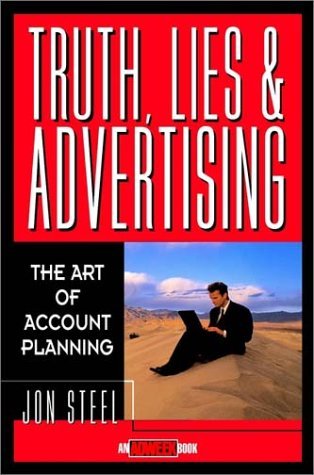 Nell'ambito della nostra serie di recensioni di libri di marketing, abbiamo recentemente recensito "Verità, bugie e pubblicità: l'arte della pianificazione dell'account" di Jon Steel. Sebbene focalizzato sulla pubblicità, il contenuto del libro può essere applicato in modo fattibile ad altri rami dei servizi di marketing. In particolare, eravamo ansiosi di leggere la sua prospettiva sulle ricerche di mercato nelle campagne pubblicitarie.
Nell'ambito della nostra serie di recensioni di libri di marketing, abbiamo recentemente recensito "Verità, bugie e pubblicità: l'arte della pianificazione dell'account" di Jon Steel. Sebbene focalizzato sulla pubblicità, il contenuto del libro può essere applicato in modo fattibile ad altri rami dei servizi di marketing. In particolare, eravamo ansiosi di leggere la sua prospettiva sulle ricerche di mercato nelle campagne pubblicitarie.
L'obiettivo di Steel è proporre un nuovo modello di pubblicità basato sulla complessità delle persone e delle loro emozioni. Il modello incorpora una partnership di stakeholder in una campagna pubblicitaria:
- prospettiva di business del cliente
- prospettiva creativa dell'agenzia
- opinions and prejudices of the people at whom advertising is aimed; In other words, the consumer needs to be probed for insecurities, motivations, habits, and prejudices
Nel “triangolare” queste prospettive, è possibile individuarle più vicine alla verità. Alla base di questo modello c’è il suo apprezzamento per il caos. La giustificazione di Steel è che la somma del tutto è maggiore delle singole parti. Al contrario, se si lascia che una prospettiva prevalga, la qualità e l’efficacia di una campagna pubblicitaria possono risentirne. Il caos, indica Steel, può essere utile per fornire il miglior lavoro ai clienti.
- L'ambiente che influenza la ricerca sulla pubblicità
- In che stato d'animo li mette?
- Possibilità (dovrebbe essere incoraggiata)
Steel prosegue inoltre tracciando un inaspettato parallelo tra la fisica quantistica e la pubblicità, in riferimento al caos. In definitiva, Steel implica che il caos e il desiderio di prospettive contrastanti nella fisica quantistica sono simili al suo approccio di prospettive diverse.
Steel continues to define Advertising according to Jeff Goodby’s definition: getting into one’s mind and changing one’s mind, but not telling one how to think. Along these lines, Steel asserts that Advertising cannot sell something; instead it influences the mind, which can influence purchasing.
Quindi la pubblicità è arte o business? Goodby affermò che la pubblicità è il mestiere di cambiare mentalità. Sembra quindi che la pubblicità sia un mix di arte e commercio, tendente al commercio. Concepire la pubblicità principalmente come un'arte è problematico in quanto solleva il problema di anteporre gli interessi del creativo a quelli del cliente. Steel implica che gli inserzionisti debbano rendersi conto che l'obiettivo dei propri clienti è vendere prodotti o idee.
Del resto, la pubblicità è una scienza o un'arte? Steel afferma che la pubblicità non è una scienza perché trascura la complessità delle emozioni umane. La scienza presuppone che sia possibile scomporre i componenti e ricostruire le cose secondo il modello della macchina di Margaret Wheatley. Dati eccessivamente scientifici possono, secondo Steel, concentrarsi sugli alberi e trascurare la foresta.
Steel writes about the power of the unscientific method. He cites evidence that some of the best brains, including Einstein, Oppenheimer (a physicist), and Watson/Crick, deviated from the scientific method by combining science and art (intuition, fantasy). Steel implies that this occurred because these great thinkers realized that the scientific method could not explain everything.
Contestualmente, la pubblicità deve affrontare diversi problemi nel raggiungere i consumatori. La pubblicità è diretta alle persone e cerca di dire loro cosa fare. I messaggi sono stati abusati. Di conseguenza, alle persone non piace la pubblicità. Steel propone che la Santissima Trinità nella pubblicità sia composta da:
- semplicità
- buon senso
- creatività
Idee sulla ricerca
Steel asserts that clients assume that those on the outside share their same amount of knowledge, and that it was the role of the planner needs to change this. He indicates that the focus group moderator should have the power to introduce a completely new idea and deviate from the discussion guide. For example, he worked on a project on “Disability Insurance,” which by itself is a word that makes people shudder. Exploratory research was employed to allow the respondent to freely think and speak her thoughts. He found that respondents considered disability insurance as a necessary evil. As a result, the resulting ad campaign focused on the wide picture of the future and the realities that would impact some of the population. The message was that the company had your interests at heart.
Steel also claims that researchers need to look at what is not being said. Citing the example of a project for KPMG Peat Marwick, he had conducted many interviews with high-level executives. All research interviews consisted of the respondent telling the interviewer that what they were saying was all confidential. Hence, he came up with the idea to make a slogan conveying the exciting, stealthy, and confidential nature of what KPMG did.
In definitiva, il libro contiene esempi rinvigorenti di pubblicità creative. Il suo stile di scrittura di facile lettura è coerente con le sue teorie generali sulla semplicità e il buon senso nella pubblicità. Le sue teorie sulla campagna pubblicitaria sono utili per concettualizzare la campagna pubblicitaria più efficace. Il nostro unico dispiacere è stato che le sue idee sulla ricerca non aggiungevano molto valore a quelle di altri autori del genere, come Clotaire Rapaille, autore del “Codice della cultura”.



